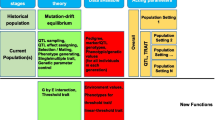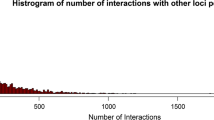Abstract
Knowledge of genetic correlations is essential to understand the joint evolution of traits through correlated responses to selection, a difficult and seldom, very precise task even with easy-to-breed species. Here, a simulation-based method to estimate genetic correlations and genetic covariances that relies only on phenotypic measurements is proposed. The method does not require any degree of relatedness in the sampled individuals. Extensive numerical results suggest that the propose method may provide relatively efficient estimates regardless of sample sizes and contributions from common environmental effects.
Similar content being viewed by others
References
Becker W. A. 1984 Manual of quantitative genetics, 4th edition. Academic Enterprises, Pullman, USA.
Cheverud J. M. 1988 A comparison of genetic and phenotypic correlations. Evolution 42, 958–968.
Cheverud J. M. 1995 Morphological integration in the saddle-back tamarin (Saguinus fuscicollis) cranium. Am. Nat. 145, 63–89.
Coyne J. A. and Beecham E. 1987 Heritability of two morphological characters within and among natural populations of Drosophila melanogaster. Genetics 117, 727–737.
David J. 1962 A new medium for rearing Drosophila in axenic conditions. Drosophila Inform. Ser. 36, 128.
Efron B. and Tibshirani R. J. 1993 An introduction to the bootstrap. Chapman and Hall, New York, USA.
Falconer D. S. and Mackay T. F. C. 1996 Introduction to quantitative genetics, 4th edition. Longman, Harlow, UK.
Hill W. G. and Thompson R. 1978 Probabilities of non-positive definite between-group or genetic covariance matrices. Biometrics 34, 429–439.
Kempthorne O. 1957 An introduction to genetic statistics. John Wiley, New York, USA.
Kendall M. G. and Stuart A. 1951 The advanced theory of statistics. Hafner, London, UK.
Laayouni H., Santos M. and Fontdevila A. 2000 Toward a physical map of Drosophila buzzatii: use of randomly amplified polymorphic DNA polymorphisms and sequence-tagged-site landmarks. Genetics 156, 1797–1816.
Lande R. 1979 Quantitative genetic analysis of multivariate evolution, applied to brain: body size allometry. Evolution 33, 402–416.
Leibowitz A., Santos M. and Fontdevila A. 1995 Heritability and selection on body size in a natural population of Drosophila buzzatii. Genetics 141, 181–189.
Loeschcke V., Bundgaard J. and Barker J. S. F. 1999 Reaction norms across and genetic parameters at different temperatures for thorax and wing size traits in Drosophila aldrichi and D. buzzatii. J. Evol. Biol. 12, 605–623.
Lynch M. 1999 Estimating genetic correlations in natural populations. Genet. Res. 74, 255–264.
Lynch M. and Walsh B. 1998 Genetics and analyses of quantitative traits. Sinauer, Sundrland, USA.
Prout T. and Barker J. S. F. 1989 Ecological aspects of the heritability of body size in Drosophila buzzatii. Genetics 123, 803–813.
Riska B., Prout T. and Turelli M. 1989 Laboratory estimates of heritabilities and genetic correlations in nature. Genetics 123, 865–871.
Ritland K. 1996 A marker-based method for inferences about quantitative inheritance in natural populations. Evolution 50, 1062–1073.
Roff D. A. 1995 The estimation of genetic correlations from phenotypic correlations: a test of Cheverud’s conjecture. Heredity 74, 481–490.
Roff D. A. 1996 The evolution of genetic correlations: an analysis of patterns. Evolution 50, 1392–1403.
Ruiz A., Santos M., Barbadilla A., Quezada-Díaz J. E., Hasson E. and Fontdevila A. 1991 Genetic variance for body size in a natural population of Drosophila buzzatii. Genetics 128, 739–750.
Searle S. R., Casella G. and McCulloch C. E. 1992 Variance components. John Wiley, New York, USA.
Weigensberg I. and Roff D. A. 1996 Natural heritabilities: can they be reliably estimated in the laboratory? Evolution 50, 2149–2157.
Willis J. H., Coyne, J. A. and Kirkpatrick M. 1991 Can one predict the evolution of quantitative characters without genetics? Evolution 45, 441–444.
Young S. S. Y. and Weiler H. 1960 Selection for two correlated traits by independent culling levels. J. Genet. 57, 329–233.
Author information
Authors and Affiliations
Corresponding author
Additional information
[Zintzaras E. 2011 Estimating genetic correlations based on phenotypic data: a simulation-based method. J. Genet. 90, 51–58]
Rights and permissions
About this article
Cite this article
ZINTZARAS, E. Estimating genetic correlations based on phenotypic data: a simulation-based method. J Genet 90, 51–58 (2011). https://doi.org/10.1007/s12041-011-0021-x
Received:
Revised:
Accepted:
Published:
Issue Date:
DOI: https://doi.org/10.1007/s12041-011-0021-x




